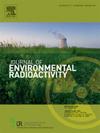Strengthening potential of recent peat dating
IF 1.9
3区 环境科学与生态学
Q3 ENVIRONMENTAL SCIENCES
引用次数: 0
Abstract
This study concerned high-resolution age reconstructions of modern organic deposits collected from peatlands distributed in Central Europe. The main focus was on 210Pb radioisotope as a fundamental geochronometer along with 14C and 239+240Pu radioisotopes used for dating verification. In addition to simple classical models such as CF/CS or CF, the new approach formulated upon the Plum method was implemented. Examined peat profiles with usually poorly defined equilibrium depth revealed a high complexity manifested by vertical variability of both 210Pb activity concentration and bulk density. The performance of dating models required prior slight corrections, which led to reliable and accurate chronologies for most of the profiles, representing various peatland types (bogs, poor fens and fens). Moreover, the age series of different 210Pb models were highly consistent for a given core. The 210Pb inventory and flux assessment exhibited maxima (SE, 1σ) of 8450 (90) Bq m−2 and 280 (20) Bq m−2 y−1, respectively, reflecting an elevated level of 222Rn exhalation in the Sudetes region. No statistically significant regularities were found in the geographical distribution of 210Pb fluxes or accumulation rates.
加强近期泥炭年代测定的潜力。
这项研究涉及中欧泥炭地收集的现代有机沉积物的高分辨率年龄重建。主要的重点是210Pb放射性同位素作为一个基本的地球计时器,以及14C和239+240Pu放射性同位素用于年代验证。除了CF/CS或CF等简单的经典模型外,还实现了在Plum方法基础上制定的新方法。在平衡深度不明确的泥炭剖面中,210Pb活度浓度和体积密度的垂直变化显示出高度的复杂性。测年模型的性能需要事先进行轻微的修正,这导致了大多数剖面的可靠和准确的年表,代表了各种泥炭地类型(沼泽、贫瘠沼泽和沼泽)。不同210Pb模型的年龄序列在同一岩心具有高度的一致性。210Pb存量和通量评价的最大SE (1σ)分别为8450 (90)Bq m-2和280 (20)Bq m-2 y-1,反映了苏台德地区222Rn呼出水平的升高。210Pb通量和累积速率的地理分布无统计学意义。
本文章由计算机程序翻译,如有差异,请以英文原文为准。
求助全文
约1分钟内获得全文
求助全文
来源期刊

Journal of environmental radioactivity
环境科学-环境科学
CiteScore
4.70
自引率
13.00%
发文量
209
审稿时长
73 days
期刊介绍:
The Journal of Environmental Radioactivity provides a coherent international forum for publication of original research or review papers on any aspect of the occurrence of radioactivity in natural systems.
Relevant subject areas range from applications of environmental radionuclides as mechanistic or timescale tracers of natural processes to assessments of the radioecological or radiological effects of ambient radioactivity. Papers deal with naturally occurring nuclides or with those created and released by man through nuclear weapons manufacture and testing, energy production, fuel-cycle technology, etc. Reports on radioactivity in the oceans, sediments, rivers, lakes, groundwaters, soils, atmosphere and all divisions of the biosphere are welcomed, but these should not simply be of a monitoring nature unless the data are particularly innovative.
 求助内容:
求助内容: 应助结果提醒方式:
应助结果提醒方式:


